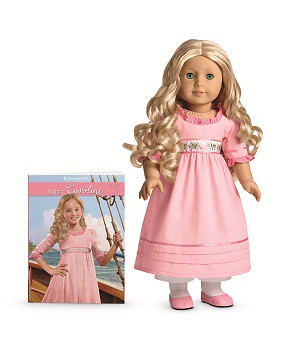One of the best things about American Girl dolls is the opportunity to make the past come alive for young girls. Each American Girl historical character is released with a series of books, featuring stories that show past time periods and historical events from a young girl's perspective. It takes a talented author to come up with plots and characters that are interesting and engaging, while imparting lessons that are relevant to girls' lives today. But American Girl authors manage to do it time and time again.
Kathleen Ernst, is one example of an American Girl author who does a great job of making history engaging and enlightening for young readers. She wrote all 6 books in the Caroline series, so I'm sure you'll be hearing a lot more about her once Caroline launches on September 4. You can check out her blog for her thoughts on Caroline and the process of writing her books; it's quite a fascinating read. For example, did you know....
* Kathleen once dressed up in period costume and participated in historical activities as a curator for the Old World Wisconsin museum.
* Kathleen has already written numerous books for American Girl, including mystery books featuring American Girl historical characters Kit, Molly, Kirsten, and Josefina.
* While doing research for the Caroline series,one of the first things Kathleen did was sail on a reproduction sloop—a ship exactly like the one described in Meet Caroline.
For fans interested in more insights into Caroline's character, I'm reprinting Kathleen Ernst's responses to some questions about Caroline and her stories. Enjoy!
What did you do to prepare to write Caroline’s stories?
I started by learning as much as I could about the War of 1812, and what life was like in the United States during that time. I read everything I could get my hands on.
Because a strong sense of place is important to me, and real places are particularly inspiring, I began to travel. The first place I visited was the USS Constitution, the world’s oldest commissioned warship afloat. Touring a ship that actually played a pivotal role during the War of 1812, and imagining the men who once worked there, was incredibly meaningful. I also lingered at the USS Constitution Museum nearby. My time there was split between learning about the war itself, and watching children to see what activities and ideas captured their imagination.
Once the decision was made to set the series in Sackets Harbor, I spent some time there to learn about local history and gain an understanding of the landscape. I timed my visit to coincide with the annual reenactment at Sackets Harbor Battlefield State Historic Site, which was helpful. I traveled to a number of museums and historic sites in New York and Canada. My husband and I also went to the Michigan Maritime Museum and sailed on Friends Good Will, a replica sloop that served as the model for the ship featured in Meet Caroline. That was great fun, and allowed me to describe the ship accurately.
I also studied the period’s material culture—artifacts in museums, historic sites, and private collections. Since we’re pre-photography, I also studied period paintings.
What surprised you most in doing the research for the Caroline books?
As I learned what it was like to be a child in rural New York during this period, what struck me most was how quickly children assumed major responsibilities on their family’s farm, or in their family’s business. For example, I found several stories of children sent alone on errands that involved overnight travel. Such examples of early maturity and responsibility were actually wonderfully inspiring, as they let me develop historically-accurate plot ideas that gave Caroline a key role in some exciting situations.
How would you describe Caroline’s personality?
Resourceful, brave, energetic, warm-hearted, fun-loving. She cares passionately about her family and friends. She is able to have fun, even in the middle of wartime. She also works hard, and shoulders some adult responsibilities. I have grown very fond of Caroline!
How would you describe Caroline’s circumstances in the story?
When the series begins, Caroline is a happy girl who loves her family and her home, and who dreams of one day captaining a ship built by her father. Her world changes abruptly and dramatically when war is declared and her father is captured by the British. Caroline soon finds many ways to face the harsh challenges of war, and to help her family, friends, and country.
Even though Caroline’s series is set 200 years ago in 1812, what lessons from her story are still relevant to girls’ lives today?
I hope that readers will see in Caroline a girl who is sometimes frustrated or frightened, but who always finds a way to make a positive difference. In Book 1, Caroline’s father encourages her to be steady, and tells her, “Everyone must sometimes face stormy seas. Good sailors learn to ride the storms through to better weather.” Caroline clings to that advice, and although she makes a few mistakes along the way, she also discovers that taking action is always better than complaining or feeling sorry for herself.
I also hope that girls value the importance of believing in themselves, and working to make their dreams come true. When Book 6 ends, Caroline’s dearest wish does come true—not exactly as she originally pictured it, perhaps, but in a way that’s authentic and meaningful and satisfying.
Why did you set the series in Sackets Harbor?
After considering the options, the editors and I chose first to focus on the War of 1812 on the Great Lakes. Fascinating and important events took place in that area—the very border between British and American soil. I was very familiar with how the war played out in Baltimore/Washington, and in New Orleans, and knew almost nothing about the key operations that took place on the lakes. I loved having the chance to shine a little light on an aspect of the war that has been largely overlooked outside of the region.
I chose Sackets Harbor specifically because the U.S. Navy based their operations there. What was a tiny, rural village on the shore of Lake Ontario quickly became a bustling hub of activity, and the shipyards there twice attracted a British attack. I saw lots of potential for a young girl like Caroline to get involved, and to grow and change as time passes. The specific events that actually took place there provided endless dramatic possibilities.
And finally, the lake/lakeside location allowed us to present a fresh new setting for loyal American Girl readers.
Were any of Caroline’s stories based on your own personal experiences growing up?
In broad terms, it was important to me that Caroline have a deep love for the natural world. Lake Ontario and its southern shore is the foundation for everything she holds dear: her home, her family’s shipyard business, the deep bond between her and Papa, fun adventures and play with family and friends, and her own dearest wish—having a ship of her own. Although I didn’t grow up beside a Great Lake, it was easy to draw on my own memories of favorite landscapes, and how they shaped my interests as a child.
What were the most challenging aspects of writing the Caroline series?
The biggest challenge was probably the relative scarcity of primary resources. It would have been delightful if a young girl or two living in the region during the war had written a diary, but we didn’t come across any. We’re pre-photography, and fewer artifacts have survived than from, obviously, later periods—especially common everyday items.
That said, though, the historian and I managed to identify more primary sources and artifacts than I’d originally hoped for.
What aspects were most rewarding?
Having the opportunity to create three generations of strong, capable women. At the beginning of the series, Caroline isn’t sure she can live up to the examples set by Grandmother and Mama. Readers will, I hope, quickly come to believe that Caroline is every bit as brave and capable as the older women.
Disclosure: I did not receive a sample or monetary compensation for this post. Kathleen Ernst interview (in italics) and photos were provided by American Girl. The views and opinions expressed here are my own.
Tweet this!
























0 Comments, Leave yours here:
Post a Comment